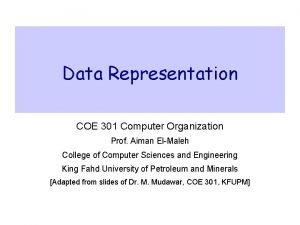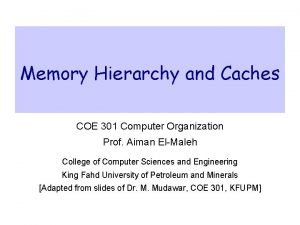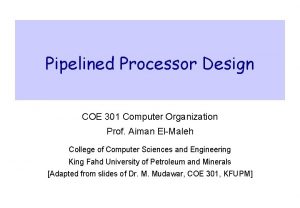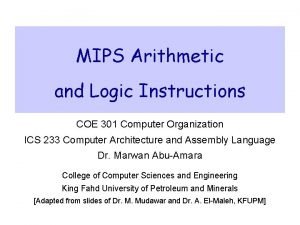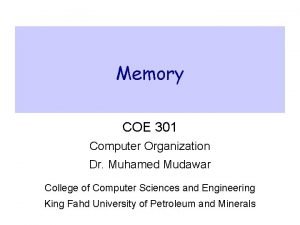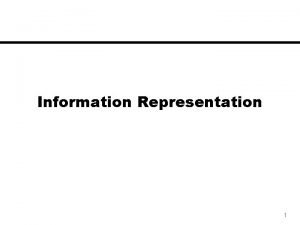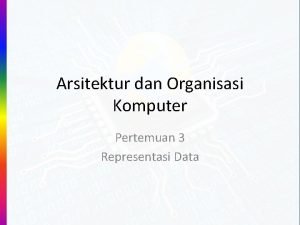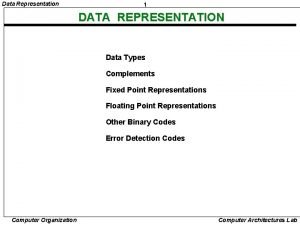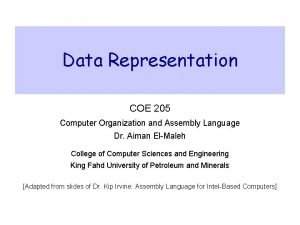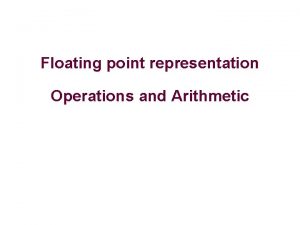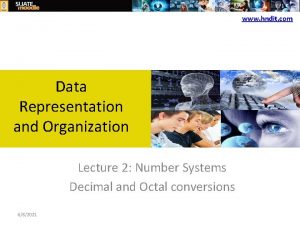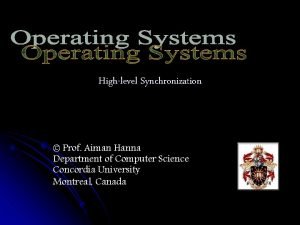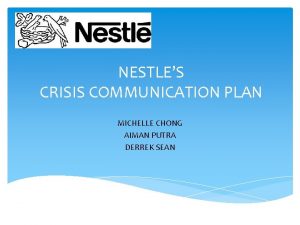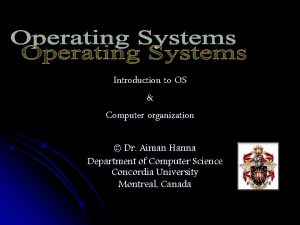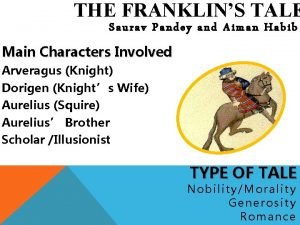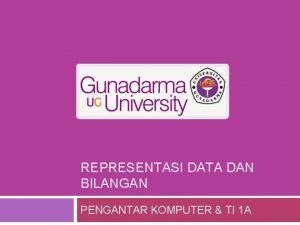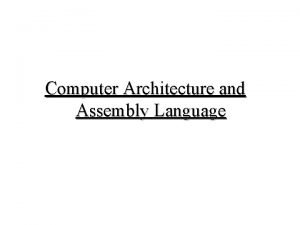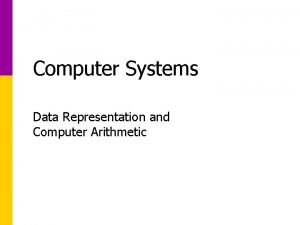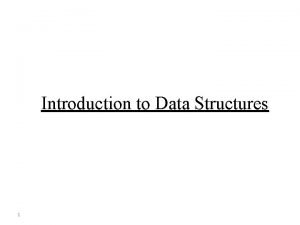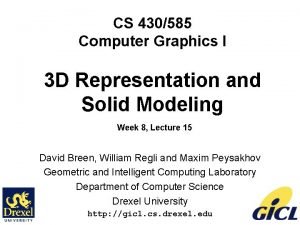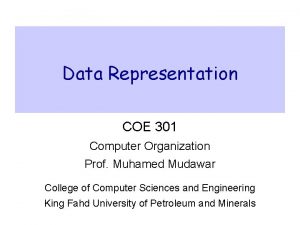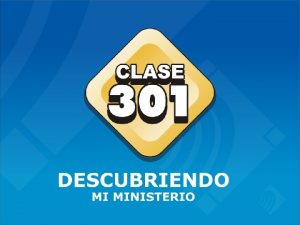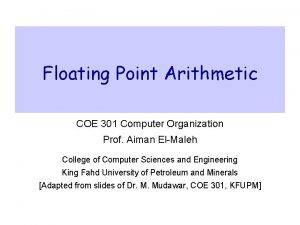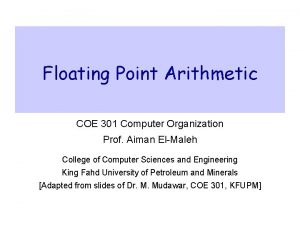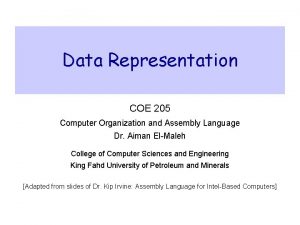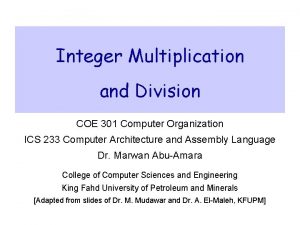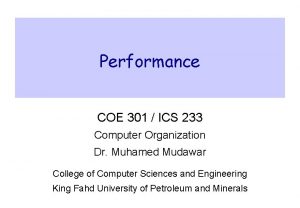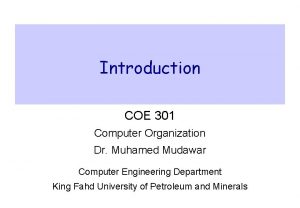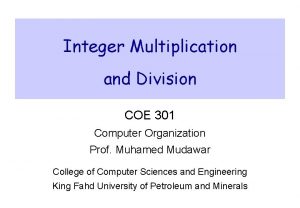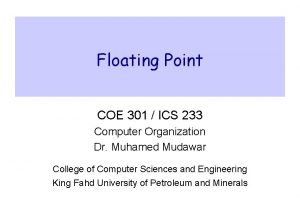Data Representation COE 301 Computer Organization Prof Aiman




























- Slides: 28

Data Representation COE 301 Computer Organization Prof. Aiman El-Maleh College of Computer Sciences and Engineering King Fahd University of Petroleum and Minerals [Adapted from slides of Dr. M. Mudawar, COE 301, KFUPM]

Outline v Positional Number Systems v Binary and Hexadecimal Numbers v Base Conversions v Integer Storage Sizes v Binary and Hexadecimal Addition v Signed Integers and 2's Complement Notation v Sign Extension v Binary and Hexadecimal subtraction v Carry and Overflow v Character Storage Data Representation COE 301 – KFUPM slide 2

Positional Number Systems Different Representations of Natural Numbers XXVII Roman numerals (not positional) 27 Radix-10 or decimal number (positional) 110112 Radix-2 or binary number (also positional) Fixed-radix positional representation with k digits Number N in radix r = (dk– 1 dk– 2. . . d 1 d 0)r Value = dk– 1×r k– 1 + dk– 2×r k– 2 + … + d 1×r + d 0 Examples: Data Representation (11011)2 = 1× 24 + 1× 23 + 0× 22 + 1× 2 + 1 = 27 (2103)4 = 2× 43 + 1× 42 + 0× 4 + 3 = 147 COE 301 – KFUPM slide 3

Binary Numbers v Each binary digit (called bit) is either 1 or 0 v Bits have no inherent meaning, can represent ² Unsigned and signed integers ² Characters Most Significant Bit ² Floating-point numbers ² Images, sound, etc. v Bit Numbering Least Significant Bit 7 6 5 4 3 2 1 0 0 1 1 1 0 1 27 26 25 24 23 22 21 20 ² Least significant bit (LSB) is rightmost (bit 0) ² Most significant bit (MSB) is leftmost (bit 7 in an 8 -bit number) Data Representation COE 301 – KFUPM slide 4

Converting Binary to Decimal v Each bit represents a power of 2 v Every binary number is a sum of powers of 2 v Decimal Value = (dn-1 2 n-1) +. . . + (d 1 21) + (d 0 20) v Binary (10011101)2 = 27 + 24 + 23 + 22 + 1 = 157 7 6 5 4 3 2 1 0 0 1 1 1 0 1 27 26 25 24 23 22 21 20 Some common powers of 2 Data Representation COE 301 – KFUPM slide 5

Convert Unsigned Decimal to Binary v Repeatedly divide the decimal integer by 2 v Each remainder is a binary digit in the translated value least significant bit 37 = (100101)2 most significant bit stop when quotient is zero Data Representation COE 301 – KFUPM slide 6

Hexadecimal Integers v 16 Hexadecimal Digits: 0 – 9, A – F v More convenient to use than binary numbers Binary, Decimal, and Hexadecimal Equivalents Data Representation COE 301 – KFUPM slide 7

Converting Binary to Hexadecimal v Each hexadecimal digit corresponds to 4 binary bits v Example: Convert the 32 -bit binary number to hexadecimal 1110 1011 0001 0110 1010 0111 1001 0100 v Solution: E B 1110 1011 Data Representation 1 6 0001 0110 COE 301 – KFUPM slide 8 A 7 9 4 1010 0111 1001 0100

Converting Hexadecimal to Decimal v Multiply each digit by its corresponding power of 16 Value = (dn-1 16 n-1) + (dn-2 16 n-2) +. . . + (d 1 16) + d 0 v Examples: (1234)16 = (1 163) + (2 162) + (3 16) + 4 = Decimal Value 4660 (3 BA 4)16 = (3 163) + (11 162) + (10 16) + 4 = Decimal Value 15268 Data Representation COE 301 – KFUPM slide 9

Converting Decimal to Hexadecimal v Repeatedly divide the decimal integer by 16 v Each remainder is a hex digit in the translated value least significant digit most significant digit stop when quotient is zero Decimal 422 = 1 A 6 hexadecimal Data Representation COE 301 – KFUPM slide 10

Integer Storage Sizes Byte Half Word 8 Storage Sizes 16 Word 32 Double Word 64 Storage Type Unsigned Range Powers of 2 Byte 0 to 255 0 to (28 – 1) Half Word 0 to 65, 535 0 to (216 – 1) Word 0 to 4, 294, 967, 295 0 to (232 – 1) Double Word 0 to 18, 446, 744, 073, 709, 551, 615 0 to (264 – 1) What is the largest 20 -bit unsigned integer? Answer: 220 – 1 = 1, 048, 575 Data Representation COE 301 – KFUPM slide 11

Binary Addition v Start with the least significant bit (rightmost bit) v Add each pair of bits v Include the carry in the addition, if present carry 1 1 0 0 1 1 0 (54) 0 0 0 1 1 1 0 1 (29) 0 1 0 0 1 1 (83) bit position: 7 6 5 4 3 2 1 0 + Data Representation COE 301 – KFUPM slide 12

Hexadecimal Addition v Start with the least significant hexadecimal digits v Let Sum = summation of two hex digits v If Sum is greater than or equal to 16 ² Sum = Sum – 16 and Carry = 1 v Example: carry: 1 1 C 37286 A + 9395 E 84 B AFCD 10 B 5 Data Representation COE 301 – KFUPM slide 13 A + B = 10 + 11 = 21 Since 21 ≥ 16 Sum = 21 – 16 = 5 Carry = 1

Signed Integers v Several ways to represent a signed number ² Sign-Magnitude ² Biased ² 1's complement ² 2's complement v Divide the range of values into 2 equal parts ² First part corresponds to the positive numbers (≥ 0) ² Second part correspond to the negative numbers (< 0) v Focus will be on the 2's complement representation ² Has many advantages over other representations ² Used widely in processors to represent signed integers Data Representation COE 301 – KFUPM slide 14

Two's Complement Representation v Positive numbers ² Signed value = Unsigned value v Negative numbers ² Signed value = Unsigned value – 2 n n = number of bits v Negative weight for MSB ² Another way to obtain the signed value is to assign a negative weight to most-significant bit 1 0 -128 64 1 1 0 0 32 16 8 4 2 1 = -128 + 32 + 16 + 4 = -76 Data Representation COE 301 – KFUPM slide 15 8 -bit Binary Unsigned value Signed value 0000 0 0 00000001 1 +1 00000010 2 +2 . . 01111110 126 +126 01111111 127 +127 10000000 128 -128 10000001 129 -127 . . 11111110 254 -2 1111 255 -1

Forming the Two's Complement starting value 00100100 = +36 step 1: reverse the bits (1's complement) 11011011 step 2: add 1 to the value from step 1 + sum = 2's complement representation 11011100 = -36 1 Sum of an integer and its 2's complement must be zero: 00100100 + 11011100 = 0000 (8 -bit sum) Ignore Carry Another way to obtain the 2's complement: Binary Value Start at the least significant 1 Leave all the 0 s to its right unchanged Complement all the bits to its left = 00100 1 00 Data Representation COE 301 – KFUPM slide 16 least significant 1 2's Complement = 11011 1 00

Sign Bit v Highest bit indicates the sign v 1 = negative Sign bit v 0 = positive 1 1 0 0 0 1 0 Negative Positive For Hexadecimal Numbers, check most significant digit If highest digit is > 7, then value is negative Examples: 8 A and C 5 are negative bytes B 1 C 42 A 00 is a negative word (32 -bit signed integer) Data Representation COE 301 – KFUPM slide 17

Sign Extension Step 1: Move the number into the lower-significant bits Step 2: Fill all the remaining higher bits with the sign bit v This will ensure that both magnitude and sign are correct v Examples ² Sign-Extend 10110011 to 16 bits 10110011 = -77 1111 10110011 = -77 ² Sign-Extend 01100010 to 16 bits 01100010 = +98 0000 01100010 = +98 v Infinite 0 s can be added to the left of a positive number v Infinite 1 s can be added to the left of a negative number Data Representation COE 301 – KFUPM slide 18

Two's Complement of a Hexadecimal v To form the two's complement of a hexadecimal ² Subtract each hexadecimal digit from 15 ² Add 1 v Examples: 2's complement of 6 A 3 D = 95 C 2 + 1 = 95 C 3 2's complement of 92 F 15 AC 0 = 6 D 0 EA 53 F + 1 = 6 D 0 EA 540 2's complement of FFFF = 0000 + 1 = 00000001 v No need to convert hexadecimal to binary Data Representation COE 301 – KFUPM slide 19

Binary Subtraction v When subtracting A – B, convert B to its 2's complement v Add A to (–B) borrow: – 1 1 1 01001101 00111010 carry: 1 1 + 00010011 1 1 01001101 11000110 (2's complement) 00010011 (same result) v Final carry is ignored, because ² Negative number is sign-extended with 1's ² You can imagine infinite 1's to the left of a negative number ² Adding the carry to the extended 1's produces extended zeros Data Representation COE 301 – KFUPM slide 20

Hexadecimal Subtraction 16 + 5 = 21 Borrow: - 1 1 1 Carry: 1 B 14 FC 675 + 839 EA 247 2 DB 1242 E 1 1 B 14 FC 675 7 C 615 DB 9 (2's complement) 2 DB 1242 E (same result) v When a borrow is required from the digit to the left, then Add 16 (decimal) to the current digit's value v Last Carry is ignored Data Representation COE 301 – KFUPM slide 21

Ranges of Signed Integers For n-bit signed integers: Range is -2 n– 1 to (2 n– 1 – 1) Positive range: 0 to 2 n– 1 Negative range: -2 n– 1 to -1 Storage Type Unsigned Range Powers of 2 Byte – 128 to +127 – 27 to (27 – 1) Half Word – 32, 768 to +32, 767 – 215 to (215 – 1) Word – 2, 147, 483, 648 to +2, 147, 483, 647 – 231 to (231 – 1) Double Word – 9, 223, 372, 036, 854, 775, 808 to +9, 223, 372, 036, 854, 775, 807 – 263 to (263 – 1) Practice: What is the range of signed values that may be stored in 20 bits? Data Representation COE 301 – KFUPM slide 22

Carry and Overflow v Carry is important when … ² Adding or subtracting unsigned integers ² Indicates that the unsigned sum is out of range ² Either < 0 or >maximum unsigned n-bit value v Overflow is important when … ² Adding or subtracting signed integers ² Indicates that the signed sum is out of range v Overflow occurs when ² Adding two positive numbers and the sum is negative ² Adding two negative numbers and the sum is positive ² Can happen because of the fixed number of sum bits Data Representation COE 301 – KFUPM slide 23

Carry and Overflow Examples v We can have carry without overflow and vice-versa v Four cases are possible (Examples are 8 -bit numbers) 1 + 1 0 0 1 1 15 0 0 1 0 0 0 8 0 0 0 1 1 1 23 Carry = 0 + Overflow = 0 1 1 1 0 0 1 1 15 1 1 1 0 0 0 248 (-8) 0 0 0 1 1 1 7 Carry = 1 1 + 1 1 0 0 1 1 79 0 1 0 0 0 64 1 0 0 0 1 1 143 (-113) Carry = 0 Data Representation Overflow = 1 COE 301 – KFUPM + slide 24 Overflow = 0 1 1 0 218 (-38) 1 0 0 1 1 1 0 1 157 (-99) 0 1 1 1 Carry = 1 Overflow = 1 119

Range, Carry, Borrow, and Overflow v Unsigned Integers: n-bit representation Numbers < min Numbers > max Borrow = 1 Subtraction Finite Set of Unsigned Integers Carry = 1 Addition max = 2 n– 1 min = 0 v Signed Integers: n-bit 2's complement representation Numbers < min Numbers > max Negative Overflow Finite Set of Signed Integers min = -2 Data Representation n-1 COE 301 – KFUPM 0 slide 25 Positive Overflow max = 2 n-1– 1

Character Storage v Character sets ² Standard ASCII: 7 -bit character codes (0 – 127) ² Extended ASCII: 8 -bit character codes (0 – 255) ² Unicode: 16 -bit character codes (0 – 65, 535) ² Unicode standard represents a universal character set § Defines codes for characters used in all major languages § Used in Windows-XP: each character is encoded as 16 bits ² UTF-8: variable-length encoding used in HTML § Encodes all Unicode characters § Uses 1 byte for ASCII, but multiple bytes for other characters v Null-terminated String ² Array of characters followed by a NULL character Data Representation COE 301 – KFUPM slide 26

Printable ASCII Codes 0 1 2 3 ! " # 4 5 6 7 8 9 A B C D E F $ % & ' ( ) * + , -. / 3 0 1 2 3 4 5 6 7 8 9 : ; < = > ? 4 @ A B C D E F G H I J K L M N O 5 P Q R S T U V W X Y Z [ ] ^ _ 6 ` a b c d e f g h i j k l m n o 7 p q r s t u v w x y z { | } ~ 2 space v Examples: ² ASCII code for space character = 20 (hex) = 32 (decimal) ² ASCII code for 'L' = 4 C (hex) = 76 (decimal) ² ASCII code for 'a' = 61 (hex) = 97 (decimal) Data Representation COE 301 – KFUPM slide 27 DEL

Control Characters v The first 32 characters of ASCII table are used for control v Control character codes = 00 to 1 F (hexadecimal) ² Not shown in previous slide v Examples of Control Characters ² Character 0 is the NULL character used to terminate a string ² Character 9 is the Horizontal Tab (HT) character ² Character 0 A (hex) = 10 (decimal) is the Line Feed (LF) ² Character 0 D (hex) = 13 (decimal) is the Carriage Return (CR) ² The LF and CR characters are used together § They advance the cursor to the beginning of next line v One control character appears at end of ASCII table ² Character 7 F (hex) is the Delete (DEL) character Data Representation COE 301 – KFUPM slide 28
 Coe 301 kfupm
Coe 301 kfupm Access memory
Access memory Coe 301 kfupm
Coe 301 kfupm Coe 301
Coe 301 Instruction format
Instruction format Mudawar
Mudawar Coe 301
Coe 301 Information representation in computer architecture
Information representation in computer architecture Data representation in computer organization
Data representation in computer organization Different types of data representation
Different types of data representation Hex code ascii
Hex code ascii Floating point addition
Floating point addition Data representation and organization
Data representation and organization Aiman hanna
Aiman hanna Michelle chong company
Michelle chong company Aiman
Aiman Aiman hanna
Aiman hanna Habib hanna
Habib hanna Aiman hanna
Aiman hanna Process organization in computer organization
Process organization in computer organization Data representation computer science
Data representation computer science Binary language
Binary language Data representation and computer arithmetic
Data representation and computer arithmetic Basic structure of computer system
Basic structure of computer system Difference between computer architecture and organisation
Difference between computer architecture and organisation Basic computer organization and design
Basic computer organization and design Simple computer design
Simple computer design Data structure operations
Data structure operations Utah teapot vertex data
Utah teapot vertex data
